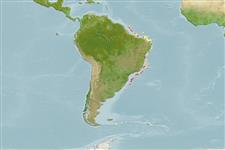Mixini (Missine) (hagfishes) >
Myxiniformes (Hagfishes) >
Myxinidae (Hagfishes) > Myxininae
Etymology: Myxine: Greek, myxinos, word used by Linne, slime fish (1846) (Ref. 45335); sotoi: Named for Jules Marcelo Rosa Soto.
Ambiente / Clima / Range
Ecologia
; marino batidemersale; non migratori; distribuzione batimetrica 690 - 810 m (Ref. 40869). Deep-water, preferred ?
Distribuzione
Stati | Aree FAO | Ecosystems | Presenze | Point map | Introduzioni | Faunafri
Southwest Atlantic: Brazil.
Size / Peso / Age
Maturity: Lm ? range ? - ? cm
Max length : 52.0 cm TL maschio/sesso non determinato; (Ref. 40869)
Short description
Morfologia | Morfometria
Color of live specimens pinkish red with whitish head anterior to first slime pore; whitish middorsal stripe extending from caudal finfold to about over gill apertures. Six pairs of gill pouches; a 2-cusp multicusp on both anterior and posterior sets of cusps, total cusps 38-44. Pores: prebranchial 28-38; trunk 61-73; tail 11-13; total 101-119. Ventral finfold 4-6 mm high.
Of 30 specimens, 26 were females, 3 males, 1 hermaphrodite. Four females had large eggs about 20 x 6 mm, but none of the eggs with encapsulated anchor filaments. The species lives on the continental slope.
Life cycle and mating behavior
Maturità | Riproduzione | Deposizione | Uova | Fecundity | Larve
Copulatory organ absent. The gonads of hagfishes are situated in the peritoneal cavity. The ovary is found in the anterior portion of the gonad, and the testis is found in the posterior part. The animal becomes female if the cranial part of the gonad develops or male if the caudal part undergoes differentiation. If none develops, then the animal becomes sterile. If both anterior and posterior parts develop, then the animal becomes a functional hermaphrodite. However, hermaphroditism being characterised as functional needs to be validated by more reproduction studies (Ref. 51361 ).
Mincarone, M.M., 2001. Myxine sotoi, a new species of hagfish (Agnatha, Myxinidae) from Brazil. Bull. Mar. Sci. 68(3):479-483. (Ref. 40869)
IUCN Red List Status (Ref. 115185)
CITES (Ref. 94142)
Not Evaluated
Threat to humans
Harmless
Human uses
Informazioni ulteriori
Age/SizeAccrescimentoLength-weightLength-lengthLength-frequenciesMorfometriaMorfologiaLarveDinamica popolazioni larvaliReclutamentoAbbondanza
BibliografiaAcquacolturaProfilo di acquacolturaVarietàGeneticaFrequenze allelicheEreditarietàMalattieElaborazioneMass conversion
CollaboratoriImmaginiStamps, CoinsSuoniCiguateraVelocitàModalità di nuotoArea branchialeOtolithsCervelliVista
Strumenti
Special reports
Download XML
Fonti Internet
